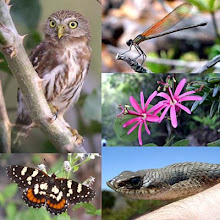September
14, 2015
We drove for
about 45 minutes south of our hotel on the main highway towards Argentina, and
then just before we left the department of Santa Cruz at the border of Chuquisaca,
we turned east through the town of Boyuibe. From here a dirt track ostensibly
leads through cattle ranches all the way to Paraguay, but I’ve never been more
than about 50 miles down it. I was first here in 2001 on an exploratory trip
with two friends, and as the first birders to ever come here, we were very
thrilled with how many chaco specialties we were able to find. Most exciting
was our discovery of Black-legged Seriemas. By now many guides and birding tour
companies have brought their groups here for the most reliable and accessible
Black-legged Seriemas anywhere. This was only my fifth time to this area of
sandy soils, dry scrub, and thorny
woodland known as the Chaco.
Tropical
Parula is one of the most abundant birds here, and any amount of pishing and
owl imitations will bring in at least a pair.
Lark-like Brushrunner
is not as common but very conspicuous as they run along the sides of the road
and, well, amongst the brush. There are so many unique members of the furnariid
family that names have been coined for each of them. This is the only
brushrunner, and there’s only one streamcreeper, one firewood-gatherer, one
chilia, one rushbird, one reedhaunter, one wiretail, etc.
There are
several canasteros, however, in the same family. Short-billed Canastero is not
rare here either, but much less conspicuous, and I used a bit of playback to
get this bird to sit up.
Yet another
member of Furnariidae is this Chaco Earthcreeper, one of the most secretive
members of the group. It took us quite a while to see one well. It and its
close relative the Bolivian Earthcreeper are not really much like other
earthcreepers and should have been called bromeliad-creepers, as they only
occur where there are dense thickets of spiny, terrestrial bromeliads.
Finally,
after hearing a few of these, we connected with a trio of Black-legged Seriemas
crossing the road. Then they were everywhere. I estimated that we saw at least
11 and heard at least 9 more today. This and the much more common and
widespread Red-legged are not only the sole members of the family Cariamidae,
they are now convincingly the only members of the entire order Cariamiformes, a
sister group to the falcons and parrots. I don’t know what line of evidence
originally placed them in the order Gruiformes with the cranes, trumpeters, rails,
Limpkin, finfoots, and flufftails, but it must have been pretty speculative.
A scarce
bird here is the Checkered Woodpecker, amazingly similar in habitat, behavior,
and voice to our Ladder-backed Woodpecker.
We have
nothing in North America that resembles the Crested Gallito, a tapaculo and the
only member of its genus. Considering its dense habitat and very secretive
nature, maybe the Australian scrub-birds are a parallel. We were extremely
lucky finally to find a bird that sat up long enough for a binocular view, let
alone long enough for me to get this photo. I’ve heard it here before, but
never saw one so well.
Here’s the group
birding on the Boyuibe road while Carlos and Benita are preparing lunch in the
back.
At lunch was
this Battus polydamas, Polydamas
Swallowtail, laying eggs on an Aristolochia
that wasn’t in bloom.
The same butterfly
also went up for nectar in this orange-flowering bush, which as close as I can
tell seems to be a Cestrum sp.
The chaco of
Bolivia is the only place where I’ve seen this Callicore sorana, Zigzag Eighty-eight.
On our way
back to Boyuibe we stopped by some ponds, pretty much the best activity in the
heat of the day. (The cold from two days ago is a dim memory, and the forecast
for tomorrow says the temps are already supposed to reach 102°F).
A migrant Baird's
Sandpiper was at one pond.
A common
bird in captivity (and sometimes showing up in North America as an escaped
bird), Ringed Teal is much more attractive as a wild bird.
We had two
surprise raptors for the day. One was a Zone-tailed Hawk that was doing very
well in passing as a Turkey Vulture, and the other was this Aplomado Falcon
that flew in front of the bus. Amazingly, it perched long enough for everyone
to get out and enjoy it.




















No comments:
Post a Comment